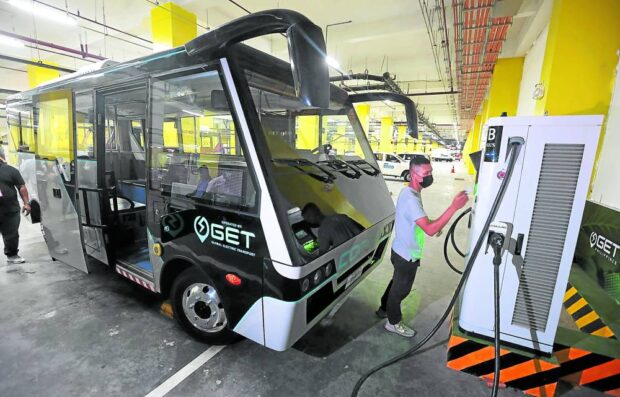
FEW AND FAR BETWEEN | An electric minibus is taken to one of the charging stations in Metro Manila in this photo taken on March 29, 2022. (File photo by MARIANNE BERMUDEZ / Philippine Daily Inquirer)
MANILA, Philippines — There is a growing demand for electric vehicles (EVs) in the Philippines, but are there enough charging stations for them?
A senator has raised this point as he called on the Department of Energy (DOE) and the Department of Public Works and Highways (DPWH) to immediately address the lack of charging stations for EVs in the country.
Sen. Sherwin Gatchalian said the DOE and the DPWH should expedite the policies governing the setup of this particular support infrastructure as an added incentive for the public to adopt green modes of transport.
“The biggest constraint in the adoption of EVs is the charging station. There’s no shortage of brands and EVs in the country, but some people are hesitant because they have nowhere to charge the EVs,” he said in a speech at the 11th Philippine Electric Vehicle Summit organized by the Electric Vehicle Association of the Philippines (Evap) on Thursday.
Targets
“So, the biggest challenge is the lack of necessary infrastructure and policies,” he added.
The senator said there was a need to amend various policies to accelerate the adoption of EVs in the country. For instance, he said, the DPWH must make revisions in the implementing rules and regulations (IRR) of the national building code and the green building code for the installation of charging stations.
Under the Comprehensive Roadmap for the Electric Vehicle Industry (Crevi), he said, the government has set a conservative target for the country to have 850,100 EVs and 20,300 EV charging stations (EVCs) by 2040.
“A more ambitious target,” he said, sets a goal for the Philippines to have more than 2 million EVs and 40,000 EVCs by 2040.
The Crevi was formulated following the enactment of the Electric Vehicle Industry Development Act (Evida) in April 2022.
Gatchalian said he had also considered proposing tax incentives for EV buyers, adding: “I’m thinking of a mechanism wherein we can refund VAT (value-added tax) to those who will switch to EVs. In effect, that is a 12-percent subsidy to those who will buy EVs.”
“It’s a refund mechanism that we are playing around with,” he said, noting that some countries already provide such subsidies to EV users.
In January this year, President Ferdinand Marcos Jr. approved cuts on import tariffs and excise on EVs and spare parts for 5 years to spur demand and bring down prices.
More recently, in a speech during an automotive industry event on Oct. 16, Marcos said he hoped to see EVs already making up 50 percent of cars on Philippine roads by 2040.
Of the country’s more than 5 million registered vehicles, only 9,000 are electric, mostly passenger vehicles, government data show.
Battery swapping
Under Evida’s IRR, which were adopted in September 2022, EV charging stations may be installed in private and public buildings and establishments identified by the Crevi.
The IRR identifies the different types of charging stations that can be set up.
For example, it can be a battery-swapping station where EV users can exchange a near-empty battery with a fully charged unit. It can also be a commercial charging station open to the general public or just to a particular group like transport cooperatives or corporations.
Private and public buildings constructed after the Evida took effect should have “at least 5 percent” of their parking slots dedicated to EVs, and these dedicated slots should come with a charging station.